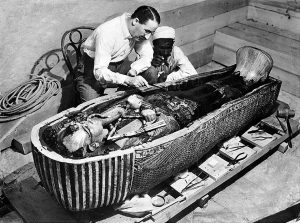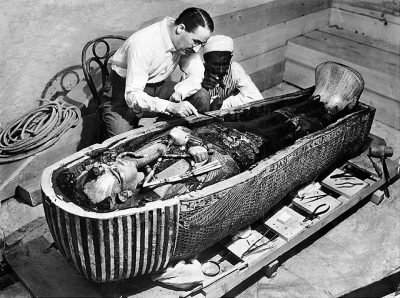 Did you know that when the craze for all things Egyptian in the early and mid 1800’s was rampant, there came to be called and what was known as ‘Mummy Unwrapping Parties’? This type of party was held by some of the most Victorian elites and it is just what the name suggests. People would gather together, at a scheduled time and event, to ‘unwrap’ a mummy. Many times there were valuable trinkets around the body, so it wasn’t all to see the ‘dead person’ inside, it was to find hidden treasures as well.
Did you know that when the craze for all things Egyptian in the early and mid 1800’s was rampant, there came to be called and what was known as ‘Mummy Unwrapping Parties’? This type of party was held by some of the most Victorian elites and it is just what the name suggests. People would gather together, at a scheduled time and event, to ‘unwrap’ a mummy. Many times there were valuable trinkets around the body, so it wasn’t all to see the ‘dead person’ inside, it was to find hidden treasures as well.
The first ‘mummy unwrapping party’ or gathering is believed to have been held by Giovanni Belzoni. He was an Egyptian antiquity dealer who in 1821 decided to unwrap a mummy near Piccadilly Circus in front of an audience. It’s popularity, and growing attraction with Egyptian artifacts, became widespread, to where more and more of mummy unwrappings occurred.
It is difficult to say how many priceless mummies, and their hidden treasures, were lost to history at this time. It was a craze with little respect for preserving valuable clues and relics of significance. We now realize to treasure them.
Here are ten fun facts of Egyptian Mummies.
1) Egyptians started making mummies around 3400BC; but it wasn’t until around 2600BC when they began to remove the dead body’s internal organs before wrapping. This helped the body from rotting away internally. Eventually they began to dry the bodies out completely for 40 days before wrapping!
2) Those responsible to wrap the bodies, the Embalmers, used to use tree resin and/or sap to make the linen strips stick together and secure them in place, almost like sticky tape.
3) The very word ‘Mummy’, as meaning a mummified body, comes from the Arabic word ‘mumia’ which means pitch or bitumen. Originally people believed that this substance was responsible for the lasting mummification process. One of the first persons to write about the process was Herodotus, a writer-historian who travelled to Egypt in around 450 B.C.
4) When all the stuffing and wrappings are removed most mummies weigh only 5 pounds.
5) In the 17th century, the English King Charles II believed that ‘mummy dust’ contained the secret to greatness. He own a small collection of mummies and had the dust that fell from them collected. He would rub it into his skin, thinking that the power would ‘rub off’ on him.
6) A famous concept of Mummies is that they are meant to be cursed. Indeed, some have been found with spell enchantments that are meant to protect them, but the belief of a curse is mostly fiction.
7) Indeed, one of the first ‘novels’ to be based on an Egyptian curse was written by the author Louisa May Alcott in 1869. She is more famous for writing the story ‘Little Women’. The name of her Egyptian tale was first called ‘Lost in a Pyramid’, but was later titled ‘The Mummy’s Curse’.
8) The passion of Mummies and curses continues with such Hollywood Blockbusters such as ‘The Mummy’ and ‘The Mummy Returns’. These films were produced through Universal Studios and were so popular that their combined box office earnings are recorded as being in excess $350,000,000.00! Although the film ‘The Mummy Returns’ is credited with a huge mistake, with 5 canopic jars to hold the organs of the deceased, as ancient Egyptians used only 4 canopic jars.
The addition of the lion-headed canopic is incorrect; no lion-headed jar exists. Perhaps it was artistic license, an attempt to convey how this mummy managed, unlike most cinematic mummies, to remain intelligent, as most depictions of mummies show them with hardly the mental ability to walk and moan, let alone talk constructively. As such, perhaps this jar contained the mummies brain! The reason for this being a notion of being different is because the ancient Egyptians didn’t seem to give the brain much significance, and to remove it from a corpse they used to stick a rod up the nose of the dead and whisk the brain into a paste and then suck it out through the nose – one very gross milk shake!
9) Artists from the 16th through to the 19th century used to have to mix their own paints and developed a mixture of paint called ‘Mummy Brown’, which was made from ground-up Mummies. The mixture was composed from white pitch and myrrh, mixture with ground mummy to produce a rich brown pigment. The paint was commonly used amongst the Pre-Raphaelite painters such as William Beechey and Martin Drölling. Although the process is no longer used, the actual shade of paint is still called ‘Mummy Brown’ and is now a combination of kaolin, quartz, goethite and hematite, the hematite and goethite.
10) Many mummies are yet to be discovered, or identified, one of the most famous is that of the Egyptian Queen Cleopatra, whose burial place still remains a mystery.
You also might be interested in reading: Lost Treasures: Top Ten Famous Tombs to be Found


Jenny,
I’m not sure how to describe my feelings about the removal of the brain to the milkshake imagery. Just not sure on that one yet.
Thanks for all you do! Happy Halloween to come.
The most recent hire always got the brain sucking job.
I Love mummies